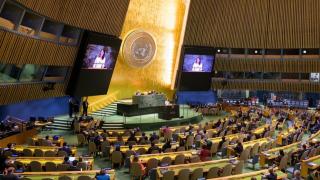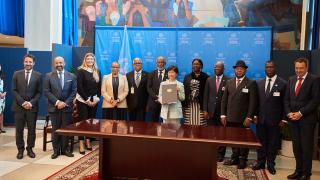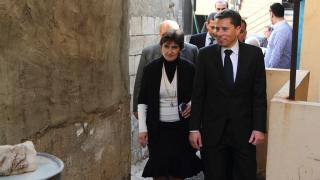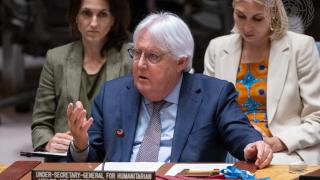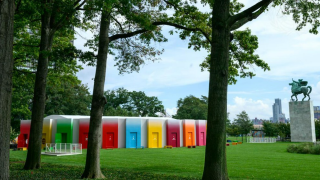
This briefing was authored by Giovanna Kuele, a policy advisor at the Igarapé Institute and a PhD Candidate at the Graduate Center of the City University of New York. The Igarapé Institute contributed to the "Our Common Agenda" report, leading a global digital consultation to support the Executive Office of the Secretary-General, and its President and Co-Founder serves at the UN High Level Advisory Board on Effective Multilateralism.
In a world grappling with devastating crises – from the aftermath of the COVID-19 pandemic and the interminable Russo-Ukrainian war to the ferocity of this year’s climate catastrophes – existing global response mechanisms are obviously inadequate.
Despite the shadow cast by widening geopolitical divisions, there may still be a path towards positive change – in Robert Frost's timeless words: "Two roads diverged in a wood, and I / I took the one less traveled by, / And that has made all the difference." Like the poet’s traveller, the United Nations stands at a fork in the road. A sequence of high-profile summits beckons: the Sustainable Development Goals (SDG) Summit in 2023, the Summit of the Future (SOTF) in 2024, and the World Social Summit in 2025.
Of these, the SOTF looms the largest, as it provides a stage for the three UNs – Member States, Secretariat, and civil society – to feed into a "Pact for the Future", intended to be endorsed by all countries at the highest level. Targeted as the summit's key deliverable, the Pact’s ambitious aim is to present actionable commitments for fast-tracking the SDGs, fortifying global peace and security architecture, pioneering digital cooperation, redressing yawning governance gaps, and catalysing the revamping of the UN's main bodies. The summit’s assembly of heads of state has the potential to become a watershed moment for the most comprehensive package of UN reforms since the 2005 World Summit.
However, there is a risk that this pivotal moment will be squandered. The world today grapples with challenges that are larger in magnitude and more encompassing than those faced almost two decades ago, ranging from US-China competition to emerging areas of global governance. Deepening global divisions and increasing polarisation in the international arena threaten diplomatic consensus, making significant progress appear ambitious.
The success of the SOTF will ultimately hinge on the Member States' ability to overcome the current landscape of intense polarisation and divisions, prioritising shared goals.
To assess the promise of the SOTF, it is helpful to draw parallels to the political environment and trajectory of the run-up to the 2005 World Summit. This article draws lessons from the UN’s 60th anniversary in 2005 and highlights the stepping stones that have led to the planned SOTF: from the UN’s 75th anniversary in 2020 through to the Our Common Agenda (OCA) initiative in 2021, and the High-Level Advisory Board on Effective Multilateralism (HLAB) in 2022 to this year’s preparations for the SOTF.
UN Global Summits as Catalysts: The 2005 World Summit's Legacy
The 60th anniversary of the UN underscored the potential of global summits. Like the current process, the 2005 World Summit was energised by a high-level panel consisting of former heads of state and independent thought leaders, a Secretary-General's report, and participation by non-state actors. In both instances, negotiations on the outcome document was/will be led by Member States.
Despite the tumultuous backdrop, marked by polarisation after the Bush administration’s Iraq invasion and some controversial issues absent from the outcome document, the summit was highly impactful. While debates continue regarding the desirability of some of the reforms, others are widely regarded as significant successes. In 2005, world leaders endorsed the Millennium Development Goals (MDGs), gained global buy-in for the Responsibility to Protect (R2P) doctrine to prevent mass atrocities, established the UN's role in facilitating global counter-terrorism cooperation, and ushered in significant institutional reforms such as the establishment of the Human Rights Council and the Peacebuilding Commission.
A key driving force was Kofi Annan's landmark report "In Larger Freedom" which at the time represented the most comprehensive take on UN reform until António Guterres’ "Our Common Agenda". Encompassing three pillars (development, peace and security, and human rights), Annan outlined two pathways for Security Council reform, proposed revitalising measures for the General Assembly and the Economic and Social Council, and advocated for the establishment of the Peacebuilding Commission. In doing so, it set the stage for the negotiations that led to the World Summit outcome document. Inputs from civil society informed the outcome, especially during the High-Level Panel on Threats, Challenges and Change deliberations.
A prevailing sentiment among Member States, the UN Secretariat, and civil society that multilateralism needed a shot of adrenaline helped pave the way for what has been the most comprehensive reform package in the UN's annals.
Path to the SOTF: Linking Anniversaries and Landmark Reports
Drawing parallels with the 2005 World Summit, the 2024 Summit of the Future is a crucial follow-up to the UN's 75th anniversary. In 2019, the UN General Assembly adopted Resolution 73/299, co-facilitated by Singapore and Iceland. The chosen theme, "The future we want, the United Nations we need" led to the adoption of a political declaration on 21 September 2020, co-facilitated by Sweden and Qatar. The declaration's journey was challenging, with negotiations spanning five months and facing significant obstacles, notably from the Trump-led US administration over references to the SDGs and the Paris Agreement. Furthermore, COVID-19 complicated matters, leading to an unprecedented virtual UN General Assembly in 2020.
The declaration outlined 12 specific commitments to multilateralism and tasked the Secretary-General with drafting a "common agenda" to tackle present and future challenges. Various civil society initiatives fed into the process to inform the declaration, mobilised through what the UN described as "the largest ever global conversation". In the preparations for the UN’s 75th anniversary, over 1.5 million individuals and 50,000 organisations worldwide responded, resulting in priorities and recommendations for building a better world for all.
The follow-up was Guterres’ Our Common Agenda (OCA) report, presented in September 2021, followed by another round of global consultations with the UN system, Member States, thought leaders, youth representatives, and civil society throughout 2021. The report proposed a broad set of ideas for change, envisioning a reshaped and reinvigorated role for the UN in collective global action. Emphasising the need for more inclusive and networked multilateralism, the report proposed a Summit of the Future to forge what Guterres called "a new global consensus", complemented by the creation of the Secretary-General’s High-Level Advisory Board to support these efforts.
Framing the Future: Insights from HLAB and Policy Briefings
To help operationalise OCA and strengthen progress towards the SOTF, the Secretary-General set in motion two simultaneous initiatives in 2022: the High Level Advisory Board on Effective Multilateralism (HLAB) and a series of eleven Policy Briefs, to be produced by the secretariat in response to resolutions 76/6 and 76/307.
The HLAB, composed of ten eminent persons and co-chaired by Ellen Johnson Sirleaf and Stefan Löfven, produced the "Breakthrough for People and Planet" report in April 2023. This report outlined six pivotal shifts from restoring trust in the multilateral system through enhanced accountability to strengthening governance for transnational risks. Each shift was supported by specific recommendations, with insights into new priorities, such as clean energy access and digital transition, and longer-standing issues, such as Security Council reform.
In turn, the in-depth policy briefs covered Future Generations, Emergency Platform, Youth Engagement, Beyond GDP, Global Digital Compact, Information Integrity, International Financial Architecture, Outer Space, New Agenda for Peace, Transforming Education, and United Nations 2.0. While these policy briefs present myriad recommendations, the top priorities to be championed by the Secretary-General towards the SOTF are yet to crystalize.
Framing the Future: Preparations for the Summit
In 2022, Member States began the preparatory process for the SOTF. The General Assembly adopted the modalities Resolution 76/307, co-facilitated by New Zealand and Oman. This resolution underscored the need to harmonise the SOTF with the SDG Summit of 2023, prompting a decision to convene the SOTF by 2024. As part of this strategic realignment, a key inter-ministerial preparatory meeting has been set for September 21, 2023, to determine the SOTF’s scope, including a "Pact for the Future."
If the SOTF is to fulfil its ambitious aims, state and non-state actors have their work cut out to achieve consensus and ensure outcomes match the scale of the challenges at hand.
The SOTF discussions have witnessed progress and setbacks. The co-facilitators, Germany and Namibia, were optimistic about concluding the Summit’s scope by early August 2023; however, groups such as G77/China and the Like-Minded Group (LMG, including Russia and some members of G77) pushed to extend negotiations until mid-September 2023. Indeed, multiple Member States broke the "silence procedure" over a more comprehensive version of the scope document presented in the third week of August, impeding the conclusion of negotiations. A simplified version that refrained from detailing the tracks of the Summit was consensually adopted by the General Assembly on September 1, 2023.
Simultaneously, other crucial negotiations, each pivotal to the SOTF agenda, are in progress. The SDG Summit's political declaration is anticipated for consensus adoption on 18 September 2023 after Ireland and Qatar co-facilitated consultations that witnessed the "broadest possible agreement reached" after silence was similarly broken during the process – on this occasion by the US and a group of like-minded Western states. Additionally, two significant documents – the "Declaration on Future Generations" (co-facilitated by Jamaica and the Netherlands) and the "Global Digital Compact" (co-facilitated by Sweden and Rwanda) – are projected to be annexes to the "Pact for the Future."
The negotiations on the SOTF scope and the SDG declaration offer a glimpse of Member States’ priorities that will inform debates around the forthcoming Pact. If the SOTF is to fulfil its ambitious aims, state and non-state actors have their work cut out to achieve consensus and ensure outcomes match the scale of the challenges at hand.
Anticipating the "Pact for the Future": A Blueprint for Tomorrow
At the heart of SOTF lies the prospects of its outcome document, the "Pact for the Future," accompanied by a "Global Digital Compact" and a "Declaration on Future Generations." The scope to be adopted includes five chapters: "Sustainable Development & Financing for Development"; "International Peace and Security"; "Science, Technology and Innovation and Digital Cooperation"; "Youth and Future Generations"; and "Transforming Global Governance." The most pressing focus should be on a sustainable future for people and planet. This requires the disbursement of the SDG stimulus, revamping and accelerating International Financial Institutions (IFIs) reform, and meeting infrastructural needs in the global South by strengthening Multilateral Development Banks (MDBs). Furthermore, the Pact could generate much needed political will for nations to pledge to a green and just transition.
Enhancing multi-stakeholder engagement is crucial to accurately represent the complexities of the 21st-century world, where non-state entities are essential players and partners.
In the realm of international peace and security, the ongoing tension arising from the Russia-Ukraine war and the escalating strain between the US and China means developing nations are spotlighting UN Security Council reform with increased urgency, a longstanding but perhaps elusive goal. Numerous proposals for reform exist, yet Member States have struggled to find common ground since 1965, when the Council expanded from six to ten non-permanent members. Momentum is growing among emerging powers, and they could rally for this cause through the SOTF. Strengthening the Peacebuilding Commission, even upgrading it to a Council, which plays an increasingly vital role in the UN's peace and security architecture, could represent another important progress.
In the rapid-fire landscape of technology, the "Global Digital Compact" could serve as a much-needed means to ethically regulate AI and reduce digital divide. Particular emphasis could be placed on harmonising principles, practices, and—crucially—bridging capacity gaps, both within and between nations.
In parallel, three broader avenues for action in global governance merit consideration. First, innovative approaches are needed to establish compliance mechanisms in an anarchic international system, aiming to make both state and non-state actors more accountable. Second, the UN should advance rapid-response mechanisms to effectively handle global crises, such as the disruptive events exemplified by the COVID-19 pandemic. Finally, enhancing multi-stakeholder engagement is crucial to accurately represent the complexities of the 21st-century world, where non-state entities are essential players and partners. In this regard, increased representation for civil society should be facilitated.
Seizing the Moment: Unleashing the Potential of the Upcoming Summits
Despite widening political fault lines, the imminent trio of summits presents an opportunity that must be seized to stimulate global cooperation, advance sustainable development, and build a more inclusive and prosperous world for future generations. The success of the SOTF will ultimately hinge on the Member States' ability to overcome the current landscape of intense polarisation and divisions, prioritising shared goals. Should the negotiations for the Summit succumb to the prevailing mistrust and negativity in the global arena, the likelihood of achieving substantive results becomes unlikely.
The "Pact for the Future" will be most effective if its primary objectives are carefully crafted to embrace both developed and developing countries’ concerns. Member States should highlight a few actionable priorities within the proposed chapters instead of seeking least common denominators. Notably, civil society organisations, having already significantly influenced UN75, OCA, and HLAB consultations, can further shape SOTF outcomes through knowledge generation and advocacy. The President of the General Assembly and the soon to be appointed co-facilitators should ensure not only that CSOs are actively engaged and consulted but also have access for transparency and accountability of the process. In the ever-evolving landscape of UN reform, the significance of process can often be underappreciated but will be essential if the three UNs are to be successful in building and delivering the ambition and action we urgently need.
Photo: A view of the SDG Pavilion, a convening space and art installation on the United Nations North Lawn supported by Project Everyone. Credit: UN Photo/Mark Garten.

